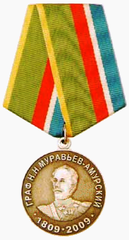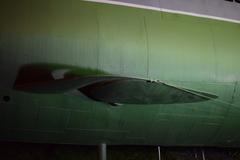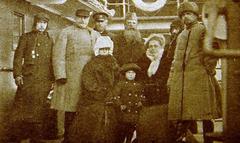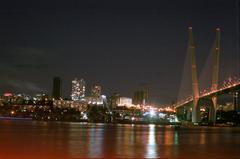Fort Pospelov Visiting Hours, Tickets, and Comprehensive Guide to Vladivostok Historical Sites
Date: 14/06/2025
Introduction
Fort Pospelov, a prominent feature of the Vladivostok Fortress complex on Russky Island, stands as a testament to Russia’s military foresight and engineering prowess in the Far East. Built during the late 19th and early 20th centuries amidst growing tensions with Japan and Western powers, this fortress was crucial in protecting Vladivostok—Russia’s primary Pacific port and the terminus of the Trans-Siberian Railway. While it never saw direct combat, Fort Pospelov played a vital deterrent role during the Russo-Japanese War and World War I. Today, it serves as both a preserved military relic and a cultural heritage site, offering visitors panoramic sea views, access to historic tunnels, and a unique window into Russian military history (museumstudiesabroad.org; travelsetu.com; visit-primorye.ru).
This guide provides an in-depth look at Fort Pospelov’s historical background, architectural features, military role, visitor information (including hours and tickets), accessibility, nearby attractions, and practical travel tips—essential for anyone planning to explore Vladivostok’s rich historical landscape.
Contents
- Historical Context and Construction
- Architectural Features and Military Innovations
- Role in Regional Conflicts and the Soviet Era
- Revival, Preservation, and Current Condition
- Visitor Information: Hours, Tickets, Tours, Accessibility
- Cultural and Tourism Significance
- Nearby Attractions
- Frequently Asked Questions (FAQ)
- Visual Media and Maps
- Plan Your Visit
- Sources and Further Reading
Historical Context and Construction
The Vladivostok Fortress, including Fort Pospelov, was conceptualized during a period of heightened geopolitical rivalry in East Asia. With the Russian Empire concerned about its vulnerable Pacific coast in the face of Japanese and British expansion, construction of the fortress began in earnest in the late 19th century. The ambitious project, launched around 1878, saw the creation of over 1,300 military installations, ranging from fortified forts to smaller batteries and intricate tunnel networks (museumstudiesabroad.org; travelsetu.com).
Fort Pospelov, sometimes known as Fortification No. 4, was constructed on the Saperny Peninsula of Russky Island to maximize strategic coverage of the Eastern Bosphorus Strait and Golden Horn Bay. Significant investments were made—between 1910 and 1914 alone, nearly 98 billion rubles in gold were allocated to the fortress’s infrastructure—demonstrating the site’s perceived importance (museumstudiesabroad.org).
Architectural Features and Military Innovations
Fort Pospelov exemplifies Russia’s transition from traditional masonry to reinforced concrete fortifications in the early 20th century. Its design incorporates:
- Interconnected Underground Galleries and Tunnels: Allowing secure movement of troops and supplies, and protected communication.
- Reinforced Concrete Gun Emplacements: Designed to withstand heavy naval and aerial bombardment.
- Perimeter Ditches, Caponiers, and Flanking Galleries: Enhancing defensive capabilities and controlling blind spots.
- Armored Observation Posts and Cupolas: Providing protected vantage points for spotting and command.
- Underground Barracks and Magazines: Ensuring survivability during sieges and safeguarding ammunition.
The fort’s strategic location allowed overlapping fields of fire with neighboring installations, and its semi-subterranean design minimized its visibility and vulnerability (travelsetu.com).
Role in Regional Conflicts and the Soviet Era
Although Fort Pospelov never engaged in direct combat, its formidable presence helped deter attacks on Vladivostok, especially following the fall of Port Arthur in the Russo-Japanese War (1904–1905) (museumstudiesabroad.org). During World War I and later in the Soviet era, the fort remained an integral part of coastal defenses. Advances in military technology eventually made some static defenses obsolete, but the fortress continued to serve as a command post and training site, particularly through World War II (source; source).
Under Soviet administration, public access was restricted, and some areas suffered from neglect or illicit activities, such as metal scavenging (museumstudiesabroad.org).
Revival, Preservation, and Current Condition
The post-Soviet era marked a turning point for the fortress. Vladivostok’s opening to international visitors led to restoration efforts and the designation of many of its forts, including Fort Pospelov, as cultural heritage sites (travelsetu.com). Today, much of the original architecture—gun emplacements, tunnels, and observation posts—remains intact, with certain areas stabilized for public tours. Museums and interpretive centers now showcase military artifacts and educate visitors about the region’s history.
Preservation remains an ongoing challenge due to natural decay and the need for resources, but community groups and local enthusiasts are actively involved in conservation (museumstudiesabroad.org).
Visitor Information: Hours, Tickets, Tours, Accessibility
- Visiting Hours: Typically 10:00 AM–6:00 PM daily, but may vary seasonally or during special events (visit-primorye.ru).
- Tickets: Guided tour tickets cost approximately 400–1500 RUB, with discounts for students, children, and groups. Tickets can be purchased onsite or online (fortressvl.ru).
- Tours: Guided tours (available in several languages) are highly recommended for a full understanding of the fort’s history and architecture. Self-guided exploration is possible, but guided groups enjoy access to more interior spaces and expert commentary.
- Accessibility: While some outdoor areas are accessible, underground galleries and tunnels can be challenging for visitors with mobility impairments. Sturdy footwear and a flashlight are advisable.
- Facilities: Basic amenities (restrooms, gift kiosk) are available onsite; dining options are found near the nearby FEFU campus.
For the latest information on hours and tickets, consult the official museum website.
Cultural and Tourism Significance
Fort Pospelov is a focal point for military heritage tourism in Vladivostok, hosting educational programs, exhibitions, and historical reenactments, especially during Russian public holidays. The fort also serves as a venue for cultural events, blending military history with the region’s natural beauty. Panoramic views of the Sea of Japan, Russky Bridge, and Vladivostok cityscape make it a favorite for photography and outdoor activities like hiking and birdwatching (visit-primorye.ru; travelsetu.com).
Nearby Attractions
- Fort No. 7 and Fort No. 11: Additional historic forts on Russky Island.
- Vladivostok Fortress Museum: Features military artifacts and in-depth exhibits.
- Primorsky Aquarium: One of Russia’s largest aquariums.
- Far Eastern Federal University (FEFU): Modern campus with cultural programs.
- Vladivostok city center: Museums, historic architecture, and waterfront attractions (wildtrips.net; hikersbay.com).
Frequently Asked Questions (FAQ)
Q: What are the visiting hours for Fort Pospelov?
A: Usually 10:00 AM–6:00 PM daily; confirm with the official site for seasonal updates.
Q: How much are tickets?
A: Guided tour tickets range from 400–1500 RUB; discounts are available for students, children, and groups.
Q: Are guided tours available?
A: Yes, in multiple languages. Booking in advance is recommended.
Q: Is the site accessible for disabled visitors?
A: Some outdoor sections are accessible, but tunnels and galleries may be difficult for those with mobility impairments.
Q: Can I visit independently?
A: Guided tours are recommended and often required for interior access.
Q: Is photography permitted?
A: Yes, except in some sensitive areas. Flash photography may be restricted.
Q: Are pets allowed?
A: Pets are generally not permitted inside the fort.
Visual Media and Maps
High-quality images and virtual tours are available on tourism platforms and the official museum site. Maps and descriptive alt tags (e.g., “Fort Pospelov artillery view”) enhance the digital visitor experience.
Plan Your Visit
- Getting There: Russky Island is accessible via the Russky Bridge from Vladivostok. The fort is a 30–40 minute drive from the city center (wildtrips.net).
- By Public Transport: Buses and taxis operate between Vladivostok and Russky Island; the FEFU campus is a convenient waypoint.
- Parking: Free parking is available near the fort entrance.
- What to Bring: Sturdy shoes, layers for changing weather, and a flashlight for tunnels.
For updated details, download the Audiala app and follow museum social media channels.
Sources and Further Reading
- Vladivostok Fortress: Visiting Hours, Tickets, and Historical Insights into Russia’s Pacific Stronghold, 2025, Museum Studies Abroad (museumstudiesabroad.org)
- Fort Pospelov Visiting Hours, Tickets, and Historical Insights | Vladivostok’s Historic Fortress, 2025, TravelSetu (travelsetu.com)
- Fort Pospelov Visiting Hours, Tickets & History | Vladivostok Historical Sites, 2025, Visit Russia (visit-primorye.ru)
- Fort Pospelov Visiting Hours, Tickets & Guide to Vladivostok Historical Site, 2025, WildTrips (wildtrips.net)
- fortressvl.ru
- hikersbay.com



